2008 NISSAN ROGUE battery
[x] Cancel search: batteryPage 244 of 309
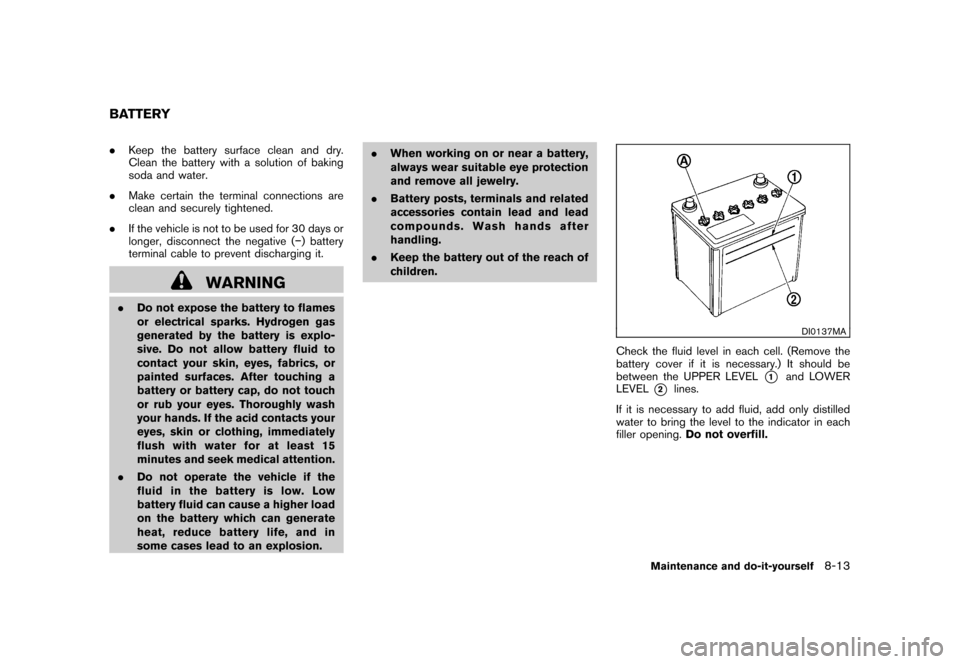
Black plate (251,1)
Model "S35-D" EDITED: 2007/ 12/ 19
.Keep the battery surface clean and dry.
Clean the battery with a solution of baking
soda and water.
.Make certain the terminal connections are
clean and securely tightened.
.If the vehicle is not to be used for 30 days or
longer, disconnect the negative (�) battery
terminal cable to prevent discharging it.
WARNING
.Do not expose the battery to flames
or electrical sparks. Hydrogen gas
generated by the battery is explo-
sive. Do not allow battery fluid to
contact your skin, eyes, fabrics, or
painted surfaces. After touching a
battery or battery cap, do not touch
or rub your eyes. Thoroughly wash
your hands. If the acid contacts your
eyes, skin or clothing, immediately
flush with water for at least 15
minutes and seek medical attention.
.Do not operate the vehicle if the
fluid in the battery is low. Low
battery fluid can cause a higher load
on the battery which can generate
heat, reduce battery life, and in
some cases lead to an explosion..When working on or near a battery,
always wear suitable eye protection
and remove all jewelry.
.Battery posts, terminals and related
accessories contain lead and lead
compounds. Wash hands after
handling.
.Keep the battery out of the reach of
children.
DI0137MA
Check the fluid level in each cell. (Remove the
battery cover if it is necessary.) It should be
between the UPPER LEVEL
*1
and LOWER
LEVEL
*2
lines.
If it is necessary to add fluid, add only distilled
water to bring the level to the indicator in each
filler opening.Do not overfill.
BATTERY
Maintenance and do-it-yourself
8-13
Page 245 of 309
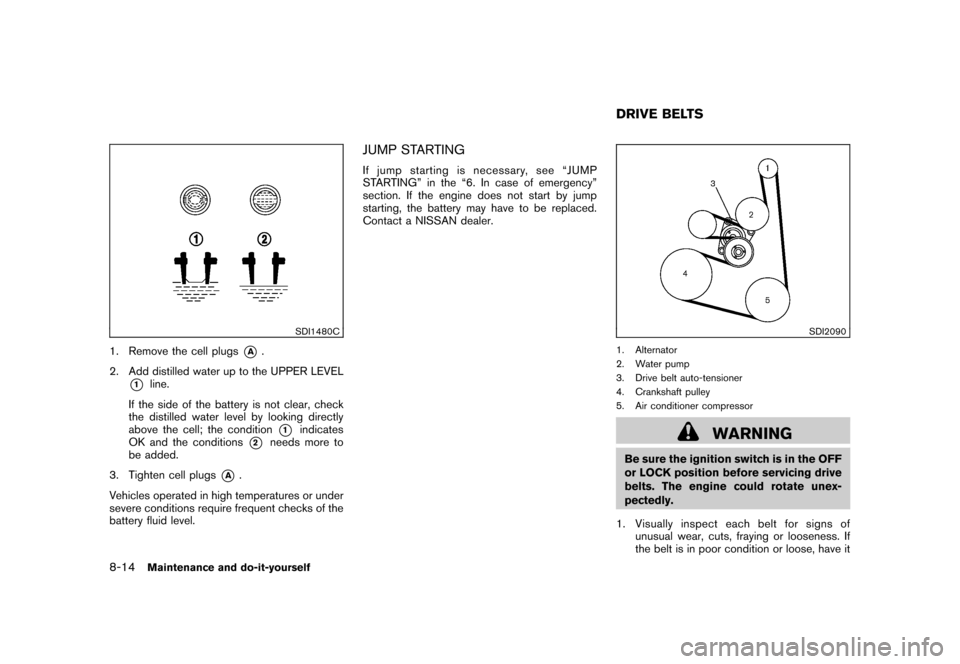
Black plate (252,1)
Model "S35-D" EDITED: 2007/ 12/ 19
SDI1480C
1. Remove the cell plugs
*A
.
2. Add distilled water up to the UPPER LEVEL
*1
line.
If the side of the battery is not clear, check
the distilled water level by looking directly
above the cell; the condition
*1
indicates
OK and the conditions
*2
needs more to
be added.
3. Tighten cell plugs
*A
.
Vehicles operated in high temperatures or under
severe conditions require frequent checks of the
battery fluid level.
JUMP STARTINGIf jump starting is necessary, see “JUMP
STARTING” in the “6. In case of emergency”
section. If the engine does not start by jump
starting, the battery may have to be replaced.
Contact a NISSAN dealer.
SDI2090
1. Alternator
2. Water pump
3. Drive belt auto-tensioner
4. Crankshaft pulley
5. Air conditioner compressor
WARNING
Be sure the ignition switch is in the OFF
or LOCK position before servicing drive
belts. The engine could rotate unex-
pectedly.
1. Visually inspect each belt for signs of
unusual wear, cuts, fraying or looseness. If
the belt is in poor condition or loose, have itDRIVE BELTS
8-14
Maintenance and do-it-yourself
Page 252 of 309
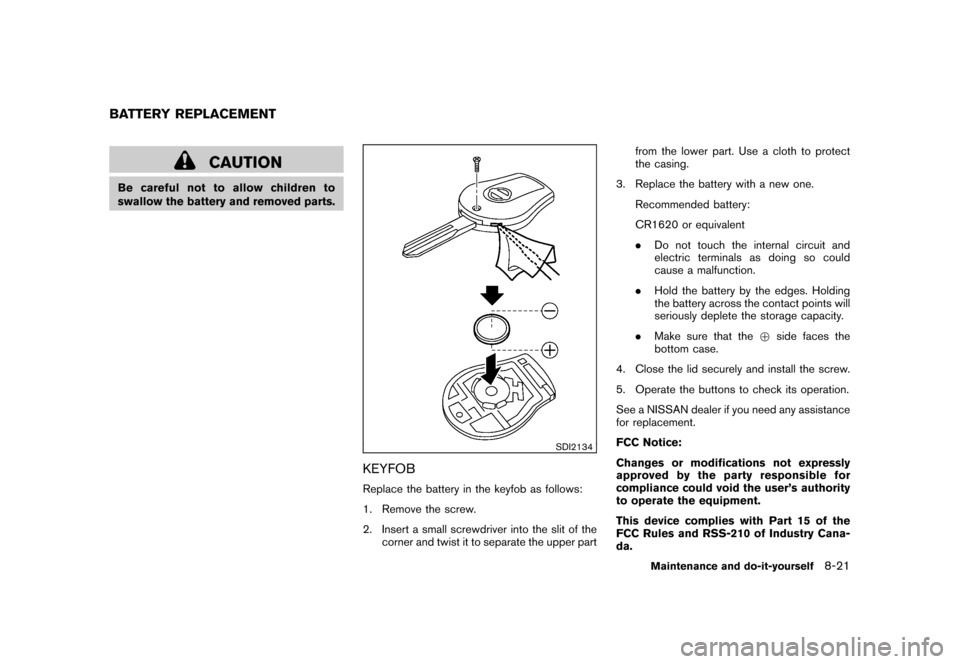
Black plate (259,1)
Model "S35-D" EDITED: 2007/ 12/ 19
CAUTION
Be careful not to allow children to
swallow the battery and removed parts.
SDI2134
KEYFOBReplace the battery in the keyfob as follows:
1. Remove the screw.
2. Insert a small screwdriver into the slit of the
corner and twist it to separate the upper partfrom the lower part. Use a cloth to protect
the casing.
3. Replace the battery with a new one.
Recommended battery:
CR1620 or equivalent
.Do not touch the internal circuit and
electric terminals as doing so could
cause a malfunction.
.Hold the battery by the edges. Holding
the battery across the contact points will
seriously deplete the storage capacity.
.Make sure that the+side faces the
bottom case.
4. Close the lid securely and install the screw.
5. Operate the buttons to check its operation.
See a NISSAN dealer if you need any assistance
for replacement.
FCC Notice:
Changes or modifications not expressly
approved by the party responsible for
compliance could void the user’s authority
to operate the equipment.
This device complies with Part 15 of the
FCC Rules and RSS-210 of Industry Cana-
da.
BATTERY REPLACEMENT
Maintenance and do-it-yourself
8-21
Page 253 of 309
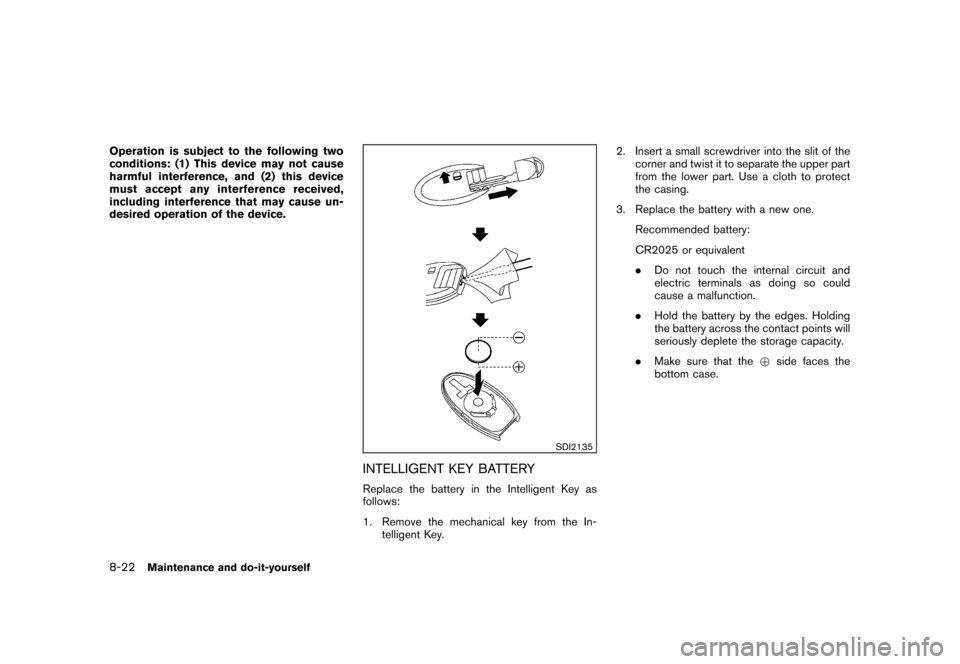
Black plate (260,1)
Model "S35-D" EDITED: 2007/ 12/ 19
Operation is subject to the following two
conditions: (1) This device may not cause
harmful interference, and (2) this device
must accept any interference received,
including interference that may cause un-
desired operation of the device.
SDI2135
INTELLIGENT KEY BATTERYReplace the battery in the Intelligent Key as
follows:
1. Remove the mechanical key from the In-
telligent Key.2. Insert a small screwdriver into the slit of the
corner and twist it to separate the upper part
from the lower part. Use a cloth to protect
the casing.
3. Replace the battery with a new one.
Recommended battery:
CR2025 or equivalent
.Do not touch the internal circuit and
electric terminals as doing so could
cause a malfunction.
.Hold the battery by the edges. Holding
the battery across the contact points will
seriously deplete the storage capacity.
.Make sure that the+side faces the
bottom case.
8-22
Maintenance and do-it-yourself
Page 257 of 309
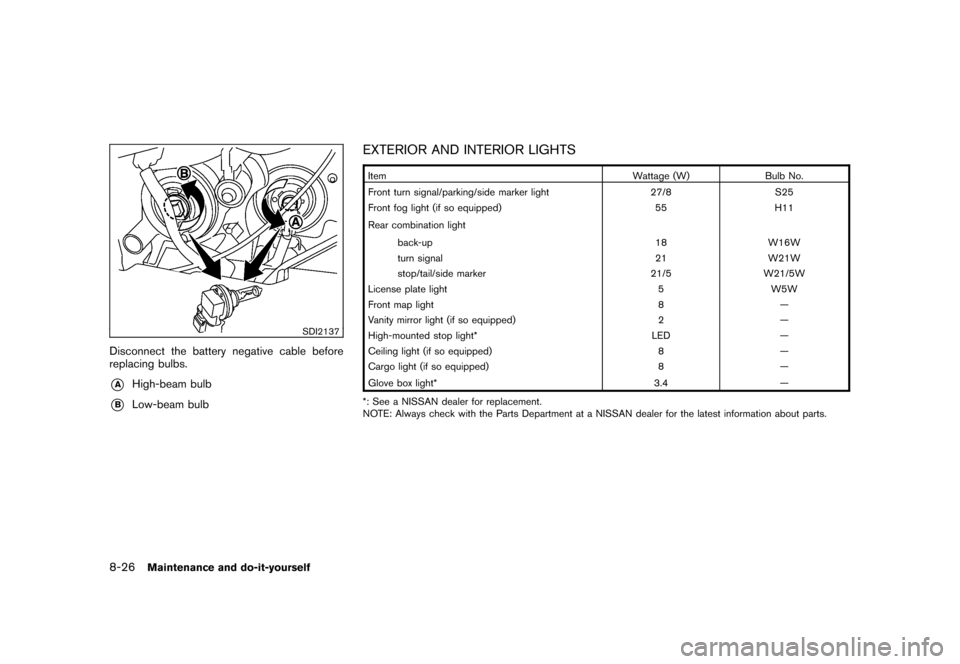
Black plate (264,1)
Model "S35-D" EDITED: 2007/ 12/ 19
SDI2137
Disconnect the battery negative cable before
replacing bulbs.*A
High-beam bulb
*B
Low-beam bulb
EXTERIOR AND INTERIOR LIGHTSItem Wattage (W) Bulb No.
Front turn signal/parking/side marker light 27/8 S25
Front fog light (if so equipped) 55 H11
Rear combination light
back-up 18 W16W
turn signal 21 W21W
stop/tail/side marker 21/5 W21/5W
License plate light 5 W5W
Front map light 8 —
Vanity mirror light (if so equipped) 2 —
High-mounted stop light* LED —
Ceiling light (if so equipped) 8 —
Cargo light (if so equipped) 8 —
Glove box light* 3.4
—
*: See a NISSAN dealer for replacement.
NOTE: Always check with the Parts Department at a NISSAN dealer for the latest information about parts.
8-26
Maintenance and do-it-yourself
Page 292 of 309
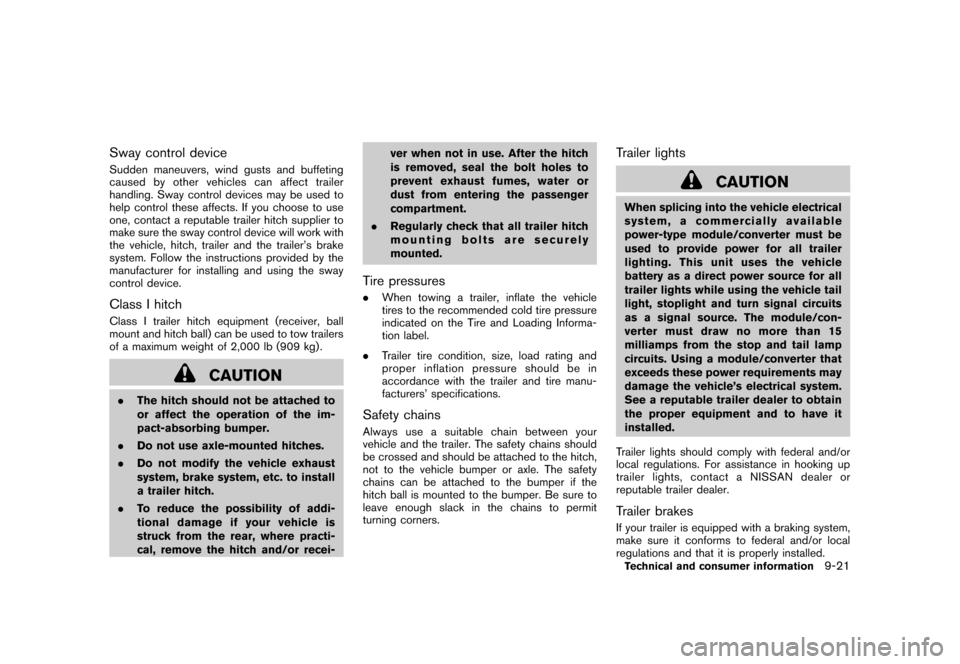
Black plate (301,1)
Model "S35-D" EDITED: 2007/ 12/ 19
Sway control deviceSudden maneuvers, wind gusts and buffeting
caused by other vehicles can affect trailer
handling. Sway control devices may be used to
help control these affects. If you choose to use
one, contact a reputable trailer hitch supplier to
make sure the sway control device will work with
the vehicle, hitch, trailer and the trailer’s brake
system. Follow the instructions provided by the
manufacturer for installing and using the sway
control device.Class I hitchClass I trailer hitch equipment (receiver, ball
mount and hitch ball) can be used to tow trailers
of a maximum weight of 2,000 lb (909 kg) .
CAUTION
.The hitch should not be attached to
or affect the operation of the im-
pact-absorbing bumper.
.Do not use axle-mounted hitches.
.Do not modify the vehicle exhaust
system, brake system, etc. to install
a trailer hitch.
.To reduce the possibility of addi-
tional damage if your vehicle is
struck from the rear, where practi-
cal, remove the hitch and/or recei-ver when not in use. After the hitch
is removed, seal the bolt holes to
prevent exhaust fumes, water or
dust from entering the passenger
compartment.
.Regularly check that all trailer hitch
mounting bolts are securely
mounted.
Tire pressures.When towing a trailer, inflate the vehicle
tires to the recommended cold tire pressure
indicated on the Tire and Loading Informa-
tion label.
.Trailer tire condition, size, load rating and
proper inflation pressure should be in
accordance with the trailer and tire manu-
facturers’ specifications.Safety chainsAlways use a suitable chain between your
vehicle and the trailer. The safety chains should
be crossed and should be attached to the hitch,
not to the vehicle bumper or axle. The safety
chains can be attached to the bumper if the
hitch ball is mounted to the bumper. Be sure to
leave enough slack in the chains to permit
turning corners.
Trailer lights
CAUTION
When splicing into the vehicle electrical
system, a commercially available
power-type module/converter must be
used to provide power for all trailer
lighting. This unit uses the vehicle
battery as a direct power source for all
trailer lights while using the vehicle tail
light, stoplight and turn signal circuits
as a signal source. The module/con-
verter must draw no more than 15
milliamps from the stop and tail lamp
circuits. Using a module/converter that
exceeds these power requirements may
damage the vehicle’s electrical system.
See a reputable trailer dealer to obtain
the proper equipment and to have it
installed.
Trailer lights should comply with federal and/or
local regulations. For assistance in hooking up
trailer lights, contact a NISSAN dealer or
reputable trailer dealer.Trailer brakesIf your trailer is equipped with a braking system,
make sure it conforms to federal and/or local
regulations and that it is properly installed.Technical and consumer information
9-21
Page 297 of 309
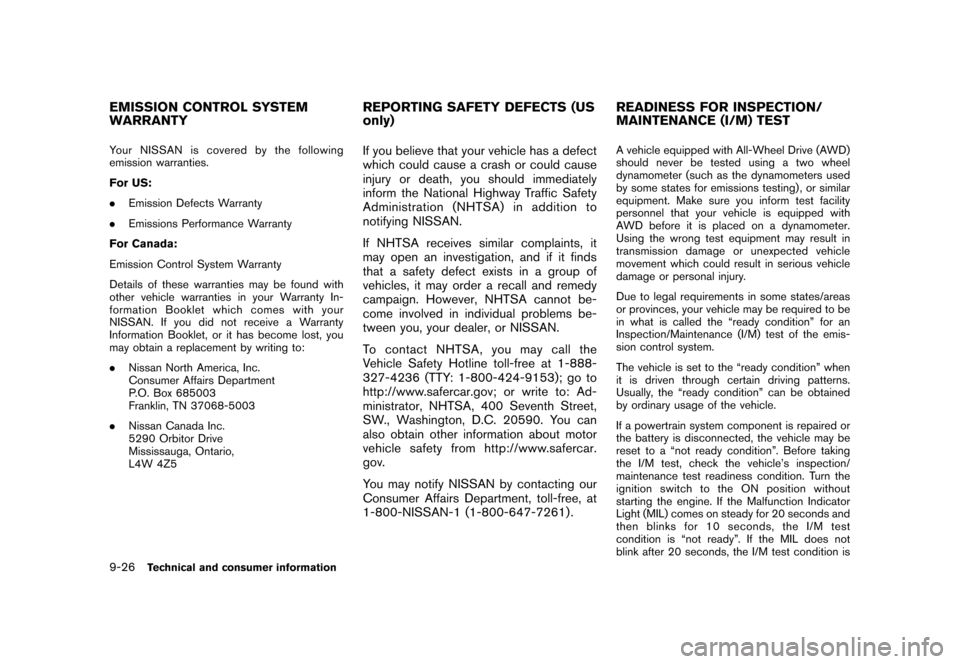
Black plate (306,1)
Model "S35-D" EDITED: 2007/ 12/ 19
Your NISSAN is covered by the following
emission warranties.
For US:
.Emission Defects Warranty
.Emissions Performance Warranty
For Canada:
Emission Control System Warranty
Details of these warranties may be found with
other vehicle warranties in your Warranty In-
formation Booklet which comes with your
NISSAN. If you did not receive a Warranty
Information Booklet, or it has become lost, you
may obtain a replacement by writing to:
.Nissan North America, Inc.
Consumer Affairs Department
P.O. Box 685003
Franklin, TN 37068-5003
.Nissan Canada Inc.
5290 Orbitor Drive
Mississauga, Ontario,
L4W 4Z5
If you believe that your vehicle has a defect
which could cause a crash or could cause
injury or death, you should immediately
inform the National Highway Traffic Safety
Administration (NHTSA) in addition to
notifying NISSAN.
If NHTSA receives similar complaints, it
may open an investigation, and if it finds
that a safety defect exists in a group of
vehicles, it may order a recall and remedy
campaign. However, NHTSA cannot be-
come involved in individual problems be-
tween you, your dealer, or NISSAN.
To contact NHTSA, you may call the
Vehicle Safety Hotline toll-free at 1-888-
327-4236 (TTY: 1-800-424-9153); go to
http://www.safercar.gov; or write to: Ad-
ministrator, NHTSA, 400 Seventh Street,
SW., Washington, D.C. 20590. You can
also obtain other information about motor
vehicle safety from http://www.safercar.
gov.
You may notify NISSAN by contacting our
Consumer Affairs Department, toll-free, at
1-800-NISSAN-1 (1-800-647-7261) .
A vehicle equipped with All-Wheel Drive (AWD)
should never be tested using a two wheel
dynamometer (such as the dynamometers used
by some states for emissions testing) , or similar
equipment. Make sure you inform test facility
personnel that your vehicle is equipped with
AWD before it is placed on a dynamometer.
Using the wrong test equipment may result in
transmission damage or unexpected vehicle
movement which could result in serious vehicle
damage or personal injury.
Due to legal requirements in some states/areas
or provinces, your vehicle may be required to be
in what is called the “ready condition” for an
Inspection/Maintenance (I/M) test of the emis-
sion control system.
The vehicle is set to the “ready condition” when
it is driven through certain driving patterns.
Usually, the “ready condition” can be obtained
by ordinary usage of the vehicle.
If a powertrain system component is repaired or
the battery is disconnected, the vehicle may be
reset to a “not ready condition”. Before taking
the I/M test, check the vehicle’s inspection/
maintenance test readiness condition. Turn the
ignition switch to the ON position without
starting the engine. If the Malfunction Indicator
Light (MIL) comes on steady for 20 seconds and
then blinks for 10 seconds, the I/M test
condition is “not ready”. If the MIL does not
blink after 20 seconds, the I/M test condition is
EMISSION CONTROL SYSTEM
WARRANTYREPORTING SAFETY DEFECTS (US
only)READINESS FOR INSPECTION/
MAINTENANCE (I/M) TEST9-26
Technical and consumer information
Page 302 of 309
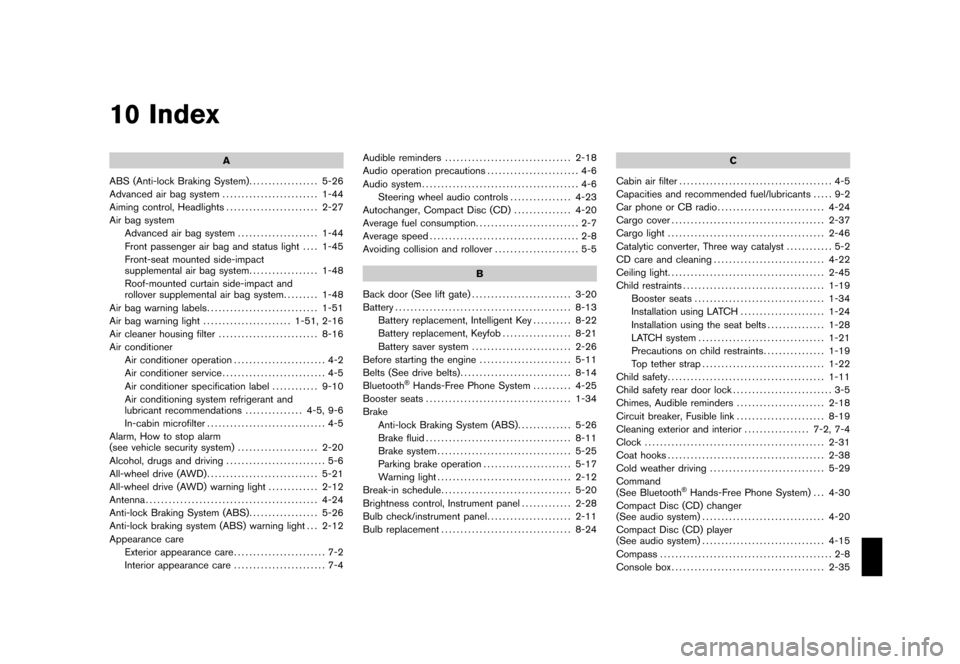
Black plate (1,1)
10 Index
A
ABS (Anti-lock Braking System).................. 5-26
Advanced air bag system......................... 1-44
Aiming control, Headlights........................ 2-27
Air bag system
Advanced air bag system..................... 1-44
Front passenger air bag and status light.... 1-45
Front-seat mounted side-impact
supplemental air bag system.................. 1-48
Roof-mounted curtain side-impact and
rollover supplemental air bag system......... 1-48
Air bag warning labels............................. 1-51
Air bag warning light....................... 1-51, 2-16
Air cleaner housing filter.......................... 8-16
Air conditioner
Air conditioner operation........................ 4-2
Air conditioner service........................... 4-5
Air conditioner specification label............ 9-10
Air conditioning system refrigerant and
lubricant recommendations............... 4-5, 9-6
In-cabin microfilter............................... 4-5
Alarm, How to stop alarm
(see vehicle security system)..................... 2-20
Alcohol, drugs and driving.......................... 5-6
All-wheel drive (AWD)............................. 5-21
All-wheel drive (AWD) warning light............. 2-12
Antenna............................................. 4-24
Anti-lock Braking System (ABS).................. 5-26
Anti-lock braking system (ABS) warning light . . . 2-12
Appearance care
Exterior appearance care........................ 7-2
Interior appearance care........................ 7-4Audible reminders................................. 2-18
Audio operation precautions........................ 4-6
Audio system......................................... 4-6
Steering wheel audio controls................ 4-23
Autochanger, Compact Disc (CD)............... 4-20
Average fuel consumption........................... 2-7
Average speed....................................... 2-8
Avoiding collision and rollover...................... 5-5
B
Back door (See lift gate).......................... 3-20
Battery.............................................. 8-13
Battery replacement, Intelligent Key.......... 8-22
Battery replacement, Keyfob.................. 8-21
Battery saver system.......................... 2-26
Before starting the engine........................ 5-11
Belts (See drive belts)............................. 8-14
Bluetooth
®Hands-Free Phone System.......... 4-25
Booster seats...................................... 1-34
Brake
Anti-lock Braking System (ABS).............. 5-26
Brake fluid...................................... 8-11
Brake system................................... 5-25
Parking brake operation....................... 5-17
Warning light................................... 2-12
Break-in schedule.................................. 5-20
Brightness control, Instrument panel............. 2-28
Bulb check/instrument panel...................... 2-11
Bulb replacement.................................. 8-24C
Cabin air filter........................................ 4-5
Capacities and recommended fuel/lubricants..... 9-2
Car phone or CB radio............................ 4-24
Cargo cover........................................ 2-37
Cargo light......................................... 2-46
Catalytic converter, Three way catalyst............ 5-2
CD care and cleaning............................. 4-22
Ceiling light......................................... 2-45
Child restraints..................................... 1-19
Booster seats .................................. 1-34
Installation using LATCH...................... 1-24
Installation using the seat belts............... 1-28
LATCH system................................. 1-21
Precautions on child restraints................ 1-19
Top tether strap................................ 1-22
Child safety......................................... 1-11
Child safety rear door lock.......................... 3-5
Chimes, Audible reminders....................... 2-18
Circuit breaker, Fusible link ....................... 8-19
Cleaning exterior and interior................. 7-2, 7-4
Clock............................................... 2-31
Coat hooks......................................... 2-38
Cold weather driving.............................. 5-29
Command
(See Bluetooth
®Hands-Free Phone System) . . . 4-30
Compact Disc (CD) changer
(See audio system) ................................ 4-20
Compact Disc (CD) player
(See audio system) ................................ 4-15
Compass............................................. 2-8
Console box........................................ 2-35
Model "S35-D" EDITED: 2007/ 12/ 25